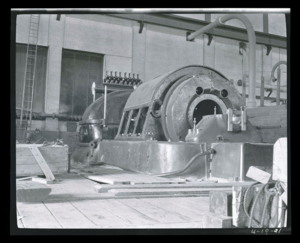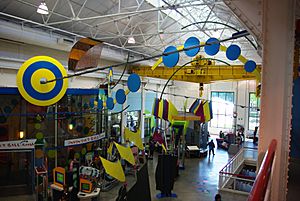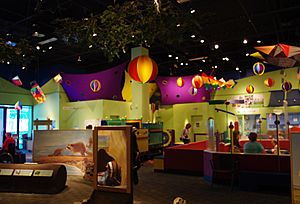Oregon Museum of Science and Industry facts for kids
 |
|
| Lua error in Module:Location_map at line 420: attempt to index field 'wikibase' (a nil value). | |
| Established | 1944 |
|---|---|
| Location | Portland, Oregon, United States |
| Type | private: science, industry |
| Visitors | 778,457 (2002) |
| Public transit access | TriMet MAX Orange Line and bus routes FX2, 9, 17, and 19; Portland Streetcar Loop Service |
The Oregon Museum of Science and Industry (OMSI, /ˈɒmziː/ OM-zee) is a science and technology museum in Portland, Oregon, United States. It contains three auditoriums, including a large-screen theatre, planetarium, and exhibition halls with a variety of hands-on permanent exhibits focused on natural sciences, industry, and technology. Transient exhibits span a wider range of disciplines.
Contents
History
Beginning in 1903, odd artifacts were displayed in hallways and alcoves in Portland City Hall arranged by Colonel L. L. Hawkins. When the collection was evicted in 1936, about 12,000 artifacts were stored throughout the city.
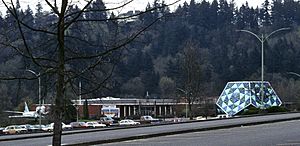
On November 5, 1944, the Oregon Museum Foundation was founded with the mission of establishing an Oregon Museum of History, Science, and Industry. It displayed its first collection of natural history objects at the Portland Hotel. Subsequent small exhibits occurred around town to generate interest and donations. In 1949, a house at 908 NE Hassalo was donated to establish the museum. Within a year, the Pacific Northwest's first public planetarium opened in a dome on the front lawn.
By 1955, OMSI's annual attendance had grown to 25,000. The need for expansion led to volunteers building a new site at Washington Park, completing the original goal of a hands-on museum. This opened to the public on August 3, 1958, following a formal dedication by the governor on June 7. A planetarium was again included. The new building at the southwest corner of what was then Hoyt Park (now part of Washington Park) was located adjacent to the then-new site of the Portland Zoo (now the Oregon Zoo), which began a one-year phased move in the same month as the new OMSI was dedicated. The two attractions remained neighbors, sharing a parking lot, until 1992. The planetarium at the Washington Park site was originally a 90-seat facility housed in a temporary dome, but in 1967 it was replaced by a larger, 142-seat facility in a distinctive dodecahedron (12-sided) building equipped with a new projector.
1992 move
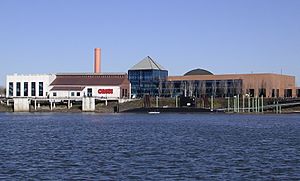
By the mid-1980s, 600,000 people per year were visiting the building, which was designed for only 100,000. Expansion at the Washington Park site was deemed infeasible, and in 1986 it was announced that the museum would move to a new location on the east bank of the Willamette River, where a much larger building would be constructed. Property that included the historic Station L power plant was donated by Portland General Electric, and building construction was paid for by a fundraising campaign. In 1992, OMSI opened at the new site, which continues to be the current location. (The building at the Washington Park site later became the Portland Children's Museum.) The construction integrated the existing PGE turbine building and included the creation of a 330-seat OMNIMAX theater. The facility also includes a 200-seat planetarium with Digistar 3 technology.
21st century
In 2004 the Turbine Hall was closed from September through November for renovations in which the Discovery Space and Technology Lab changed places and a new Inventors Ballroom was added. Also added were a small stage area for public exhibit demonstrations and a bridge connecting a new metal staircase with the mezzanine exhibits.
The museum started planning for an expansion of the facility in 2006. In 2008, OMSI began finalizing the plans for the expansion, which was estimated to cost about $500 million and would double the size of the museum. They began working to secure the funds for the expansion the next year, but decided to hold off on the plans in 2010 after the poor economy had made it difficult to try and raise funds for the project. In 2023, the city of Portland Design Commission approved a new hub in Central Eastside. This hub would be designed for science learning, arts, and culture. These plans would renovate a 10-block district and construct 1,200 units of housing space (with a focus on Indiginous heritage) and public green space.
The OMNIMAX dome theater closed in September 2013 for conversion into a conventional flat-screen movie theater that is not IMAX but still has an extra-large screen, about four stories tall. Renamed the Empirical Theater, it reopened in December 2013.
As part of the COVID-19 pandemic, the museum received between $2 million and $5 million in federally backed small business loans from Heritage Bank as part of the Paycheck Protection Program.
Exhibits and attractions
OMSI has five different specialized exhibit halls, a planetarium, and a submarine exhibit.
USS Blueback
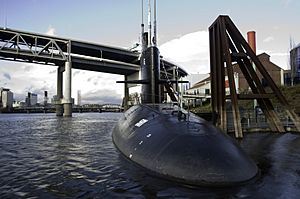
The USS Blueback (SS-581) was purchased by OMSI in February 1994. This submarine appeared in the 1990 film The Hunt for Red October before being towed to its present location, a pier adjacent to the museum. It was opened to the public on May 15, 1994, and was added to the National Register of Historic Places in September 2008. The propeller is a National Submarine Memorial located outside of the main museum area, beside the Eastbank Esplanade. The submarine is available for daily guided tours and sleep overs.
Featured Exhibit Hall
The Featured Exhibit Hall is used for temporary exhibits created by OMSI or brought in from museums around the world. Past exhibits have included "Grossology" (Winter–Spring 2001), "Giants of the Gobi" (1997), "A T-rex named Sue" (September 2001 – January 2002), and "CSI, The Experience" (May–September, 2009). Gunther von Hagens' Body Worlds 3, opened on June 7, 2007, and closed on October 7, 2007. By late September 2007, 300,000 people had seen Body Worlds 3, setting the record as OMSI's most visited traveling exhibit. In September 2015, OMSI hosted The National Guitar Museum's exhibition, "GUITAR: The Instrument That Rocked The World."
| Start date | End date | Exhibit | Links | References/notes |
|---|---|---|---|---|
| March 1, 1997 | September 1, 1997 | Giants of the Gobi | ||
| Winter 2001 | Spring 2001 | Grossology | Website | |
| September 2001 | January 2002 | A T-rex named Sue | Website | |
| June 7, 2007 | October 7, 2007 | Gunther von Hagens' Body Worlds 3 | Website | |
| May 2009 | September 2009 | CSI: The Experience | Website | |
| December 2009 | January 2011 | Samson the Colossal T. Rex Discovery | ||
| January 30, 2010 | May 31, 2010 | Space: A Journey to Our Future | Website | |
| July 2, 2011 | September 18, 2011 | Game On 2.0 | Website | |
| September 2012 | January 6, 2013 | Grossology | Website | |
| September 2015 | January 10, 2016 | GUITAR: The Instrument That Rocked The World | Website | |
| October 2, 2015 | January 3, 2016 | Genome: Unlocking Life's Code | Website | |
| February 13, 2016 | May 8, 2016 | Game Masters | Website | |
| June 18, 2016 | January 8, 2017 | Journey to Space | Website | |
| February 18, 2017 | May 29, 2017 | The Art of the Brick | Website | |
| June 24, 2017 | October 22, 2017 | Pompeii | ||
| November 18, 2017 | February 19, 2018 | Illusion: Nothing Is as It Seems | Website | |
| March 17, 2018 | September 3, 2018 | Robot Revolution | Website | |
| October 6, 2018 | January 27, 2019 | Discovery of King Tut | ||
| February 23, 2019 | September 2, 2019 | The Science Behind Pixar | Website | |
| October 5, 2019 | February 17, 2020 | Christopher Marley's Exquisite Creatures | Website | |
| March 20, 2021 | September 6, 2021 | Dinosaurs Revealed | Website | |
| March 2022 | September 2022 | The World of Leonardo da Vinci | Website | |
| October 8, 2022 | April 9, 2023 | Marvel: Universe of Super Heros | Website | |
| May 13, 2023 | January 28, 2024 | Orcas: Our Shared Future | Website | |
| March 2, 2024 | September 8, 2024 | Tyrannosaurs – Meet the Family | Website |
Turbine Hall
The Turbine Hall is named for the large retired steam turbine from its days as a PGE power plant. It features exhibits about engineering, physics, chemistry, and space travel. The Turbine Hall has two floors. On the main floor are the large exhibits and enrichment areas. On the mezzanine there are smaller exhibits.
The Innovation Station includes hands-on exhibits related to technology and invention. Laboratories for physics, chemistry, technology, and laser holography are connected to the Turbine Hall.
The Chemistry Lab is the first hands-on wet chemistry laboratory in the nation. There are six stations that allow visitors to learn about chemical interactions by participating in experiments that share a common theme. Themes rotate weekly and include the chemistry of toys, the nature of matter, biochemistry, environmental chemistry, industrial chemistry, chemical reactions, everyday chemistry, and crime scene chemistry. Chemical reaction demonstrations are given daily and are often related to the weekly theme.
Physics Lab exhibits include a Van de Graaff generator (a static electricity generator), motion detectors, electrical circuits, Morse code, magnets, computers that simulate basic properties of physics, and musical instruments.
The Laser/Holography Lab, which is open for approximately one hour every day, presents 30-minute demonstrations constructing a hologram.
The Vernier Technology Lab investigates the impact of technology on society. Rotating interactive exhibits allow visitors to investigate technologies such as robots and computers, security technology, biomedical technology, communications technology, and household technology. Visitors can also use a wide variety of educational software on internet-connected computers.
Life Sciences Hall
The Life Sciences Hall, on the second floor of the museum, offers exhibits about biology. These include a collection of preserved fetuses at nearly every stage of development, from a few weeks after conception to full-term, and the exhibit Amazing Feats of Aging, which is concerned with the biology of aging. One of the features of this exhibit is the Age Machine, a computer program that allows visitors to capture, and then "age" a picture of themselves. The Life Sciences Hall also contains the Life Science Laboratory and the Earth Science Hall.
The Life Sciences Laboratory houses a wide variety of live animals, such as rats, walking sticks, chameleons, Madagascar hissing cockroaches, other mammals, reptiles, amphibians, and insects. Volunteers and staff members demonstrate and lead a variety of a group activities such as owl pellet dissections and exploration of the differences between male and female skulls and pelvises.
Earth Science Hall
The Earth Science Hall, located on the second floor, features geology-oriented exhibits and two specialized laboratories. The Watershed Laboratory gives visitors an experience in constructing an erosion cycle out of a river physical model. Visitors can learn about the life cycle of salmon and investigate microscopic organisms from local waterways through a videomicroscope. Visitors to the Paleontology Laboratory watch staff members and volunteers excavating fossils, such as dinosaur bones.
Science Playground
The Science Playground, the early childhood education area on the second floor of the museum, is designed for families with newborn to six-year-old children. The area is fully enclosed and designed to keep children visible and secure, while giving them freedom to explore at will. Its purpose is to give children the opportunity to develop interactive scientific learning through play. It contains a variety of experimental stations intended to encourage natural curiosity including a stimulating infant area, a giant sandbox, a water area, a reading area, and physical science exhibits. The area is staffed by trained specialists in early childhood education. There is also a Parent Resource Corner with reference materials on topics ranging from the developing brain to behavior intervention techniques.
The Animal Secrets exhibit encourages children and parents to explore the hidden habitats and lives of forest animals. Visitors can crawl through the roots of a discovery tree, look for animals in a cave and a chipmunk den, play in a woodland stream, and be a naturalist for a day. Animal Secrets features English and Spanish text panels.
The Discovery Laboratory offers rotating experiments and activities such as exploring Flubber or ice cube painting. Themed Discovery Drawers encourage parents to teach their own children about the contents. OMSI is a member of Nanoscale Informal Science Education Network, and participates in NanoDays.
Planetarium
Computer-aided astronomy and laser light shows are performed daily in the Harry C. Kendall Planetarium (previously the M. J. Murdock Sky Theater).
Best Buy Teen Tech Center
On February 1, 2020, the Best Buy Teen Tech Center opened. As a partnership between Best Buy and The Clubhouse Network, the Teen Tech Center is a free, out-of-school space for teens to explore their ideas, develop skills, and express themselves through technology. Some technology that is available includes: programming, film making, music production, and graphic design.
Theory Eatery
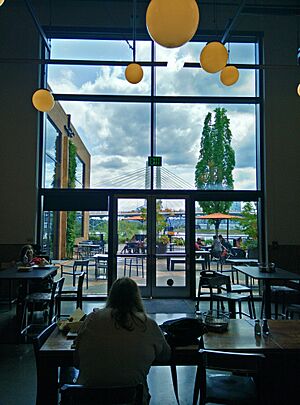
Theory Eatery, or simply Theory, is an American cuisine restaurant opened on January 30, 2013, as an addition to OMSI. Located alongside the Willamette River in the Central Eastside Industrial District, the restaurant has 9,100 square-feet of dining space. Mark Patel, former developer director of OMSI, was behind the creation of the restaurant, which is operated by Bon Appétit Management Company. The restaurant is part of the museum, and also offers exhibits, science demonstrations and private and public events. The former head chef was Ryan Morgan. In 2023, Theory reopened under the Epicurean Group management.
Theory is located off of the Willamette River, with views of the Tilikum Crossing, Marquam Bridge, and the downtown Portland skyline. In November 2013, the restaurant was redesigned, and included a new 10-by-50-foot mural of photographed ingredients arranged with formulas on the background, designed by OMSI graphic artist Melissa Hicks.
Auditoriums
OMSI contains both an ultra-large-screen theater (which replaced an OMNIMAX theater in 2013) and a large auditorium with a stage where annual events such as science fairs occur. Science fairs that take place in the main auditorium include OHSU's Brain Awareness, Safety Safari, and the Reptile and Amphibian Show. The auditorium is also used for private events.
Educational outreach
OMSI operates the largest science museum outreach program in the country. The museum offers presentations in schools, summer science camp programs for individuals, and outdoor school programs for school groups on the Oregon Coast at Camp Gray and in the John Day Fossil Beds National Monument at Hancock Field Station. OMSI is a frequent site for field trips, primarily for grades K-12, from all over the region. OMSI also runs several educational star parties in the Portland area at L.L. "Stub" Stewart State Park and Rooster Rock State Park for events such as the solstice and meteor showers, which helps teach the public about astronomy during this outreach.
OMSI offers Science Communication Fellowships for current STEM professionals. This program is open to industry or academic researchers or science professionals interested in improving their scientific communication, which includes university faculty, graduate students, technicians, or other individuals in science, engineering, health, or technology related positions. Fellows who are chosen participate in a series of communication training workshops and develop their own hands-on demonstration based on their work. Finally, the fellow participates in OMSI's Meet a Scientist program to engage with the museum visitors with their demonstration.
Funding and volunteer support
OMSI is a non-profit organization and is funded by admissions, member contributions, public, and private donations, community agencies, federal grants, and fundraising events. The largest OMSI fundraising event each year is the OMSI Gala: a black tie party in May where visitors gather to show support for science education.
Although it is staffed with full and part-time employees, much of the museum is dependent on volunteers who perform many of the same duties as staff members such as greeting visitors, customer service, and performing exhibit demonstrations. The volunteers include high school and college students as well as other community members. Volunteers serve in a wide range of areas within the museum both on-stage and off. After 50 hours of service, all volunteers receive a free, one-year museum membership.
The Teen Science Alliance, OMSI's youth volunteer program, takes place both during the summer and during the school year. As a part of the program, participants attend weekly classes focusing on developing communication and customer service skills and practice these skills by performing demonstrations on the museum floor. Participants also develop an original science demonstration for presentation to the public at the end of each session.
See also
- California Museum of Science and Industry, Los Angeles
- Museum of Science and Industry (Chicago)
- Museum of Science & Industry (Tampa), Florida
- Portland Winter Light Festival


